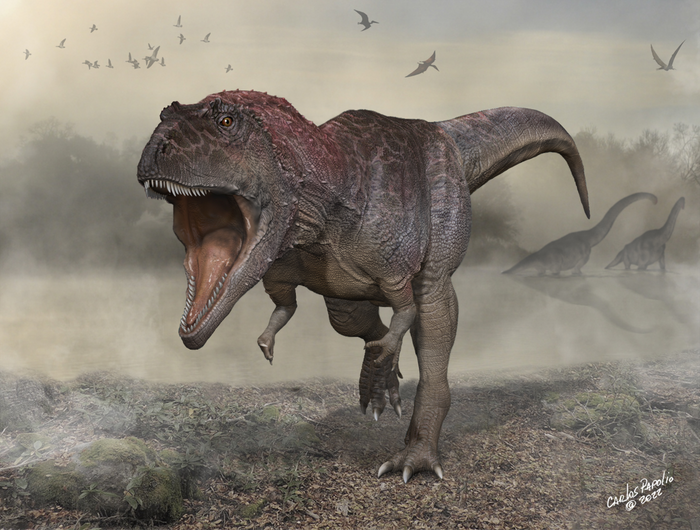Tyrannosaurus rex is arguably the most famous of the dinosaurs, renowned for its enormous teeth and gargantuan size, but also its comparatively teeny arms. The fearsome predator was around 12 meters (40 feet) long and yet its arms measured just 1 meter (3 feet). This ridiculous ratio wasn’t reserved solely for the king of the dinosaurs, however: plenty of other theropods – the clade to which T. rex belongs – had measly appendages too. But why?
Why did some theropods have such tiny arms?
The truth is, no one knows for sure. Theropods, along with all other non-avian dinosaurs, went extinct 66 million years ago, so we’ll never get to see for ourselves how they wielded their little limbs. Fortunately, palaeontologists do have some theories.

A 14-meter-long (45-foot) T. rex would’ve had arms less than a meter long. That’s the equivalent of a 1.8-meter-tall (6-foot) human having arms just 13 centimeters (5 inches) long.
Image credit: © IFLScience, Mateusz Atroszko / Bowonpat Sakaew / nale / Shutterstock
One of the first suggestions came from Henry Fairfield Osborn, who described and named T. rex in 1905. He proposed that the dinosaur’s stumpy arms may have been used as some kind of mating apparatus, which gave it an advantage during sexy times.
The hypothesis is alive and well today too. In 2022, following the discovery of Meraxes gigas – another tiny-armed theropod – project lead Juan Canale speculated on this.
“They may have used the arms for reproductive behavior such as holding the female during mating,” Canale argued in a statement. Short arms may even have helped M. gigas, and other theropods, to attract potential mates. “Sexual selection is a powerful evolutionary force. But given that we cannot directly observe their behavior, it is impossible to be certain about this.”

Meraxes gigas was rocking tiny arms 20 million years before T. rex even existed.
Canale also suggested that, despite being so puny, their dinky arms could have helped dinosaurs to get back up after a fall. Weighing in at around 7,000 kilograms (15,500 pounds) – the weight of a large African elephant – means it was likely difficult for T. rex to raise itself from the ground, so even the smallest of arms would have been a help.
“When they were rising from a crouched position, they could use the arms to do a tiny tyrannosaur push-up,” Scott Persons, head curator of the Mace Brown Museum of Natural History, told BBC Future. “[But] you’ve got to understand that that really only helps the tyrannosaur with the first two feet [0.6 meters]. And then it’s got like another 15 feet [4.5 meters] to go off the ground.”
Another idea is that stubby forelimbs may have helped theropods to avoid accidental amputation – which sounds like a big bonus to us.
“What if several adult tyrannosaurs converged on a carcass? You have a bunch of massive skulls, with incredibly powerful jaws and teeth, ripping and chomping down flesh and bone right next to you. What if your friend there thinks you’re getting a little too close? They might warn you away by severing your arm,” palaeontologist Kevin Padian explained in a 2022 press release.
In this case, having arms that don’t get in the way could be the difference between getting mauled by your mate and dodging getting chomped.
Believe it or not, some scientists have argued that T. rex’s pathetic-looking limbs could actually have been used as weapons. According to one 2017 study, they may have been adapted for “vicious slashing” – although this opinion is contested, given how ridiculously small they are. Other theories as to why some theropods had such teeny arms have included nest-digging and grooming.
Of course, there’s also the possibility that the arms served no purpose at all and were simply a relic left over from their earlier ancestors. Perhaps, faced with evolutionary pressures, the likes of T. rex spent less energy maintaining its arm size, instead funneling it into evolving longer legs or a bigger head.
“An animal can only devote so much of its body volume to one thing or another,” John Hutchinson, a biologist at the University of London’s Royal Veterinary College, told Live Science. “He can’t be a jack-of-all-trades. So you either have a very generalized body where everything’s equally specialized for some general ecological niche, or you really specialize like T. rex, who is super specialized to be a front-end predator.”
The end result is a vestigial feature, like theropod arms or the human tailbone.

Carnotaurus sastrei taking tiny arms to the extreme.
But perhaps our favorite suggestion is that some dinos, such as Carnotaurus, may have used their wee arms in a bizarre arm-twirling courtship display. Phwoar.
Hopefully, future research and fossil discoveries will help to answer some of the questions that remain about theropods’ absurd appendages. The reason behind them might be debated, but at least we can all agree they’re really very silly.
Source Link: Why Did Dinosaurs Like T. Rex Have Such Tiny Arms?